Fill Your Bathtub with Gin and Borrow the Dune Books from the Library
And other answers to questions you didn’t ask.
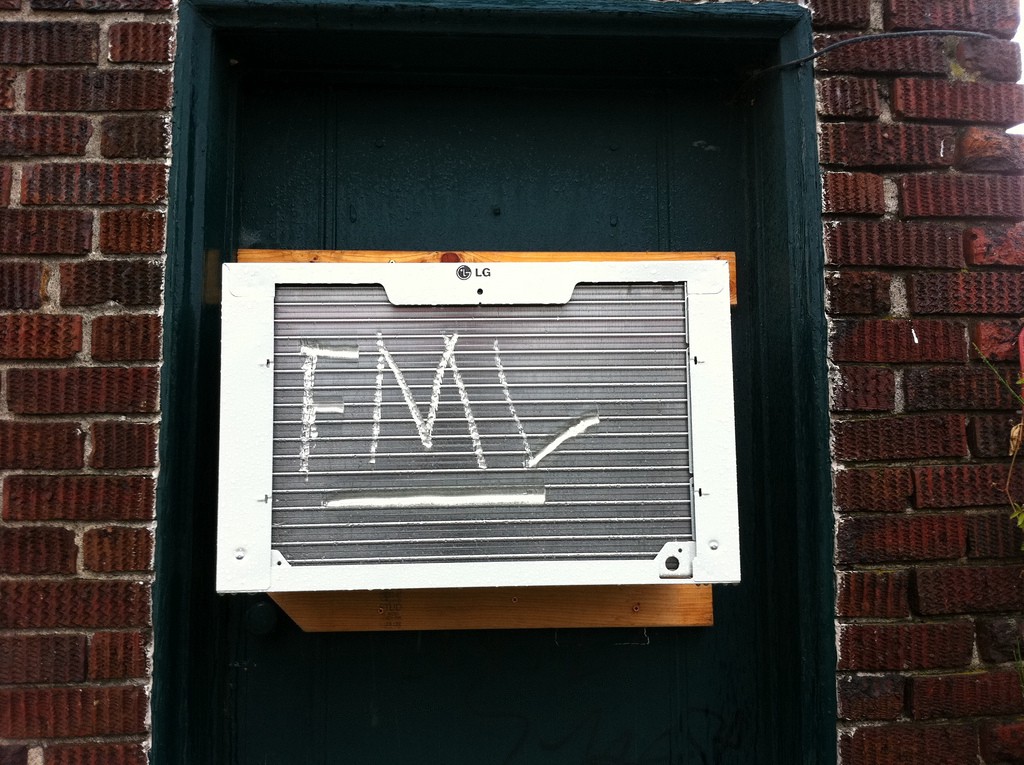
“Any tips for summer time?” — Summery Sam
Summer is once again upon us. I like to sit inside during the summer, right next to the air conditioner, in the dark, for hours and hours, and think about how we’ll all soon be dead. I mean, just pick a reason. Global warming would be the main reason. But that will probably take a while. North Korean EMP weapons, maybe. Those aren’t even real, but they’re sufficiently terrifying. Mostly I’m afraid of daleks from Doctor Who. They are so loud! Always screaming “exterminate!” as they roll around trying to kill you. Will you please shut up, daleks?
You, however, might have more ambitious summer plans. To climb things. To drink on roof decks. To get a vasectomy so gold diggers don’t trap you with a baby. That’s what summer is for. Leisurely pursuits and meaningless encounters. As we march closer and closer to winter, total darkness, another cliff overhanging an abyss of nonsense. You don’t listen to Wagner during the summer. You shouldn’t read Proust. Nobody’s brain works all that great when the sun is out. It’s time for stupidity to reign. So put your male romper on and spin, spin, spin your fidget spinner.
Everyone is very concerned about looking sexy during the summer. But I think it’s more important not to have certain parts of your body rubbing against other parts of your body. I consider summer The Chafing Season. And chafing must be avoided at all costs. Get a kiddie pool, fill it with ice, find some shade and remove yourself from society until early September. It will all still be there. The Trump Administration. Racism. Sexism. Showtime’s “The Affair,” for some reason. There is just no stopping that show. They are just going to keep making it until no one wants to have an affair again ever. Everything that you leave behind now will still be a huge honking problem in the Fall. Except you will feel more like doing something about it because the weather is less nice.
Get yourself some books. Books are great in the summer because they are mostly boring and you can fall asleep after reading the first page of The Fountainhead. Like I have. Every time I’ve tried it. Sleep is really the only truly relaxing thing. And nothing gets me there quicker than a thick, boring book. I am once again getting my box set of the Dune books down from the shelf and will venture to try to get past page 50 once again. It was bell hooks, I believe, who wrote “For in dreams we all drive Camaros.” I might be wrong about that. But it is a great quote and a great summer dream.
How have you ever even gotten to this point in this article? Shouldn’t you be enjoying a boozy drink next to the calming sound of waves next to some body of water? Summer is not made for pondering. We’ve been given this time to get away from it all. And you should use that time wisely. Tomorrow, we shall revolution! But today, pass the lemonade.
Jim Behrle lives in Jersey City, NJ and works in a bookstore.
Will Someone Please Tell Me What They Think a "Toxin" Is?
Everyone talks about them but no one knows what they are.
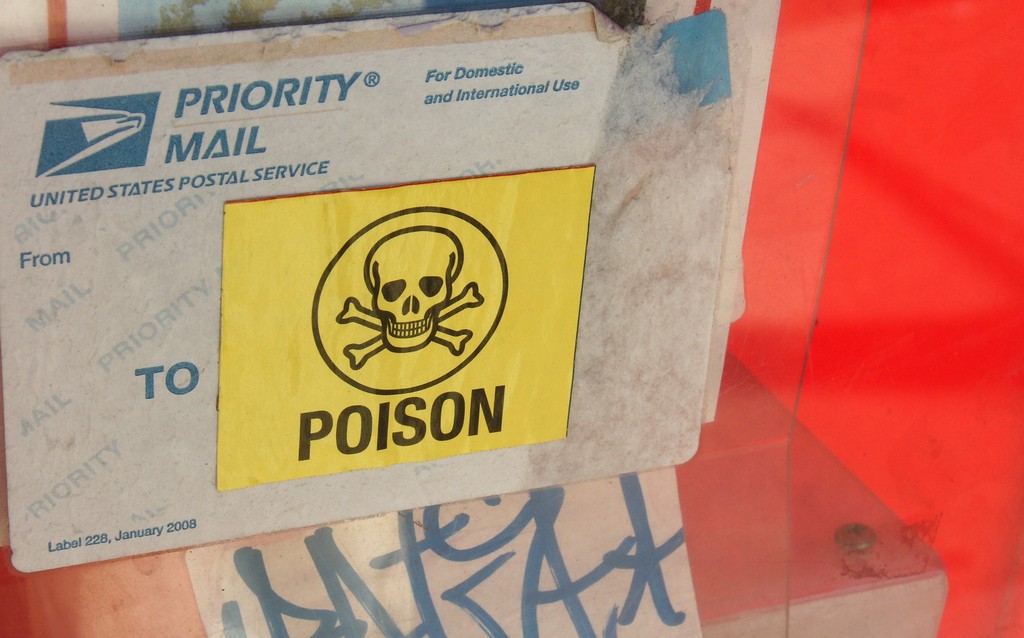
Last week, I was in an exercise class where the instructor told us to breathe deeply, and that this was a great way of “releasing toxins.” I wondered what she thought she meant by this. Also last week, I had food poisoning from some poorly cooked fish. That was the result of an actual toxin, which is to say, a POISON that made me near-immediately and violently physically ill. The technical definition of a toxin is that it is a type of poison made from organic matter—i.e., biologically, in nature, by an organism, rather than artificially synthesized.
Once upon a time, “detox” used to mean “a treatment for substance abuse or addiction.” Now it means spicy lemon water. These days you see the word “toxin” everywhere. On wellness blogs, in GOOP newsletters, in Instagram ads for clay face masks that will detoxify your face. Infrared saunas that will detoxify your fat deposits. Bullshit websites that tell you, “Any physical activity that gets your heart pumping is a great detoxification option.”


What?
No.
I’m not against doing whatever feels good and happens to be good for your well-being for, like, cosmetic or cardiological reasons, but DETOXIFICATION? No. Unless you have had Botox® (literally botulinum toxin!!!!!!!!!!!!!) injections, you are NOT walking around with actual toxins in your face. The only thing that a clay mask is drawing out of your pores is oil, dead skin cells, and probably not even really that much dirt if we’re being honest! Like, sorry, but there is no Brown recluse venom hiding out in your pores. There’s no lurking shellfish poison that you can sweat out in a sauna.
In reading all of these blogs and ads and bullshit peddlers, I have never once seen anyone acknowledge WHAT exactly they think a toxin is. You try it! Go back in your Gmail archives of all the newsletters and see if you can find one source who identifies any toxins by name or chemical compound. At best, they might say “toxic chemicals,” or “environmental toxins” but what do they mean by that? Car exhaust? Not a toxin. Bad, sure. But not a toxin. And probably not giving you zits. No one is trying to say that nitrites in processed meats don’t cause cancer—we know they do—but nitrites are not toxins and you cannot sweat or juice them out. So what the fuck are these wellness people talking about?
What’s probably happening here is a misusage of the term toxin via backformation from the adjective “toxic,” which essentially just means poisonous. Toxicant would be a more preferable, if pedantic, word for these purposes. But “poisonous” is a nebulous term—it means causing illness or death of a living organism. Does your skin’s sebum really cause you illness? Are carbs going to kill you? No. (I will make an exception here for alcohol, which I think by definition qualifies as a low-grade poison that I have the legal right to drink if I want to sometimes.) Unless of course people who think sugar is poison mean “poisonous” the same way we mean “toxic” as when talking about something less tangible, like a person, say, or an idea. This person is bad for us, that idea is no good. This is a moral judgment, not a scientific or even empirical one.
So stop calling your imaginary wellness demons “toxins.” Google around enough and you might find reference to Persistent Organic Pollutants (POPs)—synthetic organic compounds like pesticides or dioxins, which are resistant to breakdown and stored in adipose (fatty) tissue. Watered down on a wellness blog that will read something like “toxins stored in your belly fat.” Okay, sure, that is technically correct, if wildly misleading. Did you ever stop to think that your fat was actually absorbing the bad chemicals to protect your other organs and tissues from overexposure? Yes, dummy. Is that accumulation ultimately detrimental to your body too? Probably yes. All the blessings are also curses.
Eating kale isn’t going to remove “impurities” from your soul. But do whatever you want. Just please, going forward, choose your words more carefully—the toxins have gone to your head.
The High Close By
America’s addiction crisis
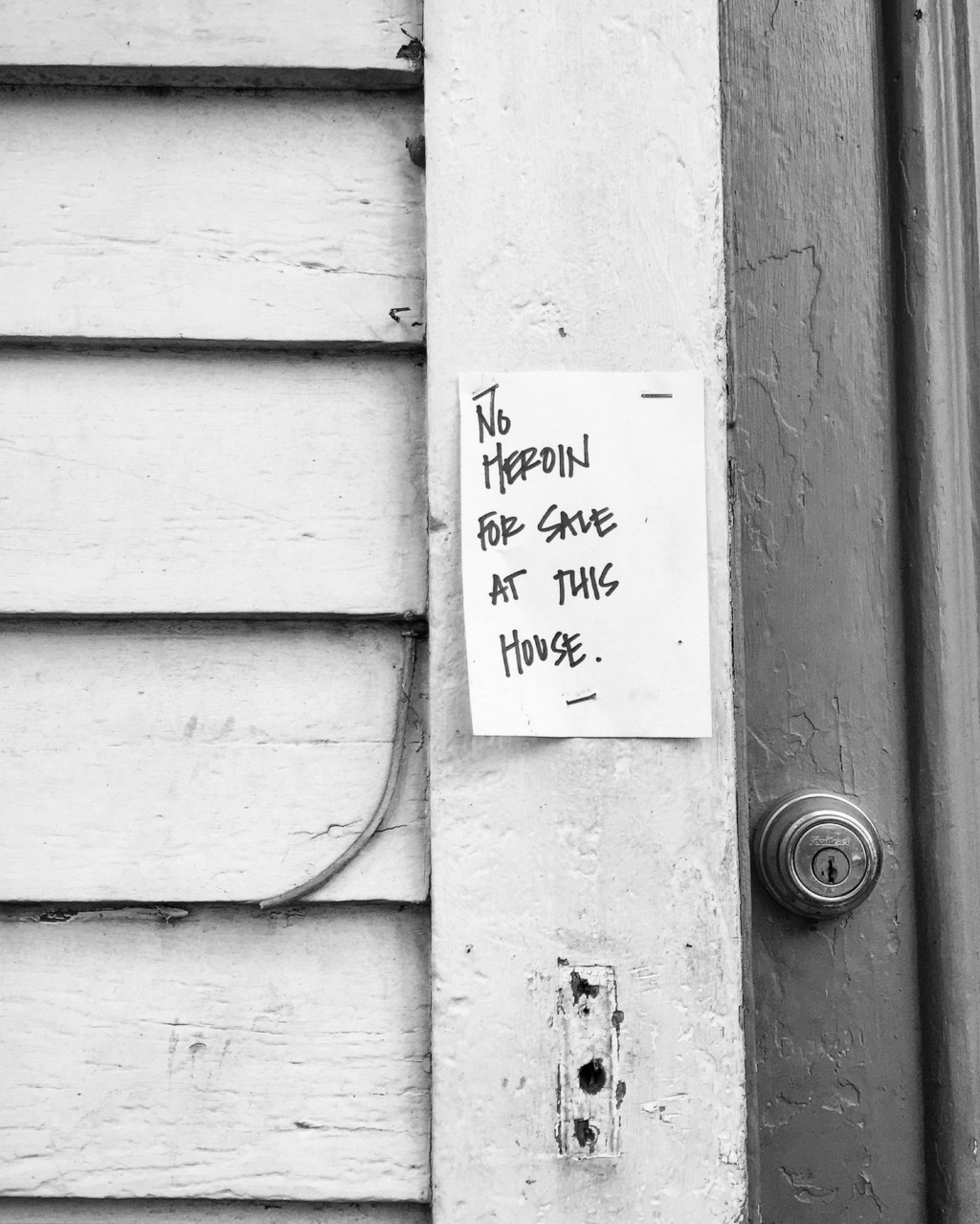
For some of us the New Yorker’s fiction issue is our favorite issue of the year because a) it’s a double, so you don’t have to worry about adding to the pile for another 14 days and b) who gives a shit about fiction, particularly now, when all of reality seems so (badly) made up. You don’t have to read anything! It’s like they’re giving you two weeks off! That said, there is an actual work of reportage in the current issue that you should make time for: Margaret Talbot’s piece on the drug crisis in West Virginia. If you’ve read any of the thousands of “addiction comes to real America” pieces that have poured forth in the last five years you won’t learn anything new here, but this is a great encapsulation of all of them and a good way to catch up if you’ve been skipping the other ones because they seem so bleak.
Max Cooper, "Chromos"
Every weekend is a wasted weekend from now on.

Welcome to summer. I wish I could be more excited but, uh, you know. At least it’s raining, right? Ugh, whatever, this is where we these days, there’s gloom whatever the weather. Here’s something terrific from the new Max Cooper EP at least. Enjoy.
New York City, May 25, 2017

★ The only good news down below the windows was that the people under their umbrellas were not steering around any sidewalk flooding or deep gutter puddles. The light was dull and the rain was soaking. In the afternoon the light strengthened and it looked as if the rain might have stopped, but it had only thinned. Umbrellas and hoods couldn’t really do anything against the moisture hanging in flecks, but it was too unpleasant not to try. A young man had ventured burgundy suede boots, with a nap that might have been able to hold off the little droplets. By evening it was back to full drizzle; the food cart operator offered the Apple Store as shelter while he cooked. It didn’t feel so bad in any moment, but the water beaded on the wallet in the time it took to finish paying. In the dark there was less of it on the wind but the wind was rising. The buildings were gnawed away by mist and people were confusing dark shadows against the shine of the still-damp pavement. Later still, a rumble too steady to be a truck was confirmed, by a flash through the blinds, to be thunder arriving.
Who Made The First Rice Krispies Treat?
Searching for Mildred Day
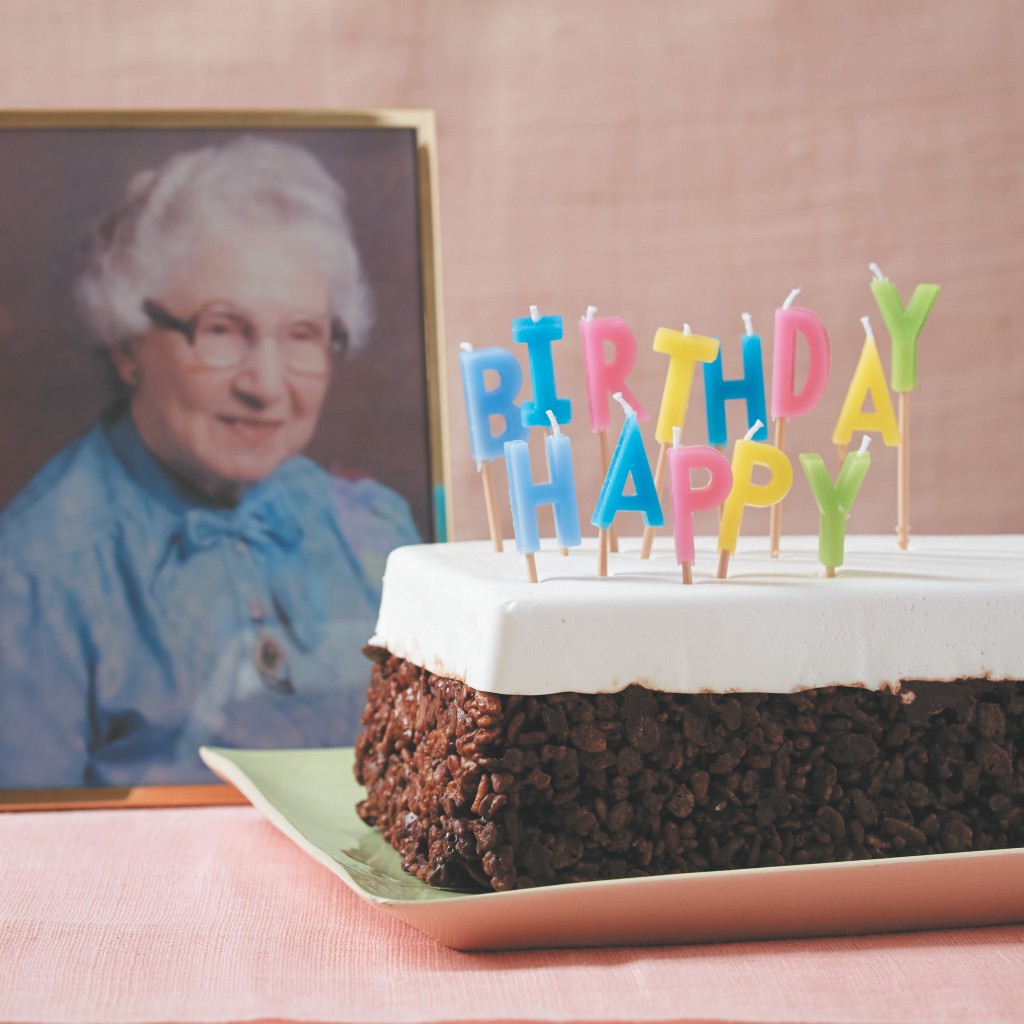
My mom never made Rice Krispies treats. She didn’t have to. It seemed like everyone else’s mother always had a batch at the ready, for birthday parties, after-school snacks, bake sales, picnics and potlucks. It was an abundance of sameness. A collected Stepford-like mind-set of puffed rice cereal, marshmallows, and butter. On occasion, there would be an exciting break in the monotony — the rare “eccentric” neighbor swapping Rice Krispies with Froot Loops, creating a multi-colored, shimmery specimen influenced by Timothy Leary. But mostly, I was bored by them (I was a very affected teen and pretended to be bored by almost everything). I took them for granted. If they were around and I was hungry, I would eat them. If they weren’t, I never thought about them.
Much later, I came back to Rice Krispies Treats, obsessively, during a period of mild self-loathing. I had just finished writing my third cookbook, Baked Elements, and I was feeling unpleasantly doughy. My gut, never exactly flat, was giddily exploring foreign territory and my skin felt uncomfortably tight. Writing a cookbook is great fun, but testing each and every recipe (some many multiples of times) can be maddening. Dessert cookbooks are doubly masochistic. It’s an unholy cycle of cake and cookies and brownies — a constant sugar high feedback loop without a lean protein or leafy green in sight.
I had been through this transformation before with my prior cookbooks, but this time was worse. I was older and less elastic. It was in this pudgy, shaky, sweaty state (instantaneous and uncontrollable sweats were another ailment I developed from consistent cookbook testing) that I ambled into a Starbucks in February 2012, and ordered their version of a Rice Krispies treat, the Marshmallow Dream Bar. I ordered it not because I was a fan, but because according to the hybrid price/nutrition card, it had less than half the calories of everything else in the pastry case. This was my form of dieting—the Dream Bar, at a mere 230 calories, was my way back to salvation.
The basic recipe for Rice Krispies treats uses only three relatively inexpensive ingredients and can be put together in about 5 minutes or less. This simplicity guaranteed its ubiquity. It is a nearly foolproof recipe with two important attributes: 1) it does not require an oven and 2) its main ingredient, puffed rice, is often completely uniform due to the brand dominance of Kellogg. Ovens are temperamental beasts at best, and sudden spikes in temperature and undiscovered “hot spots” can ruin (at least for an evening) even the most accomplished home cook. Chocolate cake can vary greatly based upon the brand of chocolate (cacao, sugar, and milk solids are vastly different from brand to brand), type of cocoa powder used (Dutch-process vs. natural), and even the amount of protein in the regional flour. But Rice Krispies treats are dependable. It is the kind of recipe that suggests a crude (or maybe shrewd) entrepreneurial skill, and bit of (subconscious) wit. Three weeks into my makeshift post-cookbook detox, I set aside a day’s worth of work to uncover the magician behind the recipe.

The origin of a recipe is often as important as the recipe itself. A recipe that is steeped in fable — a fantastic narrative seeded with bits of truth — is much more appealing to a broader public. Though not universal, most of these creation myths have a few things in common. First, the recipe inventor must be relatable — the more normal the better. Secondly, and most importantly, the creations are more viral if they are accidental. For some reason, we — and especially the media — love accidents. We love non-accidents as well (hello, Cronut), but fortunate mishaps appeal to a primal human condition: hope. And, if not hope, it’s hard not to be amused by dumb luck. After all, Ruth Wakefield accidentally created America’s most famous cookie. Or did she?

Ruth Graves Wakefield created what we have come to know as the chocolate chip cookie. The original version, the Toll House Chocolate Crunch Cookie (named after the restaurant she owned in Whitman, Massachusetts) became a sensation. Today, there is nary a soul unfamiliar with her handiwork. But the story of how Ruth created the cookie is a bit more nebulous. The official Nestlé version (per the corporate website):
One day, while preparing a batch of Butter Drop Do cookies, a favorite recipe dating back to Colonial days, Ruth cut a bar of our NESTLÉ® Semi-Sweet Chocolate into tiny bits and added them to her dough, expecting them to melt. Instead, the chocolate held its shape and softened to a delicately creamy texture.
The more probable version is more nuanced and is told from many perspectives in Carol Wyman’s wonderfully detailed and researched book, The Great American Chocolate Chip Cookie Book. Carol’s quote from Phyllis Hanes of the Christian Science Monitor sums things up nicely:
It was one year after a trip to Europe that [Ruth] remembered some chocolate experiments she…made in a college food-chemistry class. She ordered some chocolate bars from the grocery [and] after testing and experimenting, she and her pastry cook, Sue Brides, came up with a new cookie.
I was rankled by the Nestlé version of the story. I felt it demeaned Ruth’s legacy and belittled her intelligence. At face value, the Nestlé history implies — in an unflattering, retro kind of way — that Ruth’s creation was not the byproduct of careful work and research but rather a happy accident. Was there a whiff of sexism in their retelling? If Ruth were a man, would the origin story be less whimsical?
Nestlé spokesperson Roz O’Hearn was eager to report that Ruth (whom she never met, but knows much about) was a “shrewd businesswoman,” a “food scientist,” and very smart. This seems to square with Carol Wyman’s reporting as well, wherein Ruth comes across as exacting and sharp (to put it mildly). You get the sense that accidents were not tolerated in Ruth’s kitchen. When I asked O’Hearn about the discrepancy — the difference in origin stories, she said, “In the end, it doesn’t matter, they are both great stories about a great cookie.”
So what about Mildred Day, the woman attributed with inventing the Rice Krispies Treat? Unlike Wakefield, a lone entrepreneur, Day was employed by Kellogg when the Rice Krispies treat was first developed. To date, the best article I could find about Day was from The Des Moines Register in an article by Tom Longden. The profile, from a series on famous Iowans, details her life, including her time at Kellogg and beyond. In addition to creating the Rice Krispies treat, the author suggests (by way of Day’s daughter, Sandra Rippie) that Day also served the “very first airline meal…to a group of magazine food editors.”
But did Day actually design the Rice Krispies treat? I called Rippie, who told me she has fond memories of her mother, but not of Rice Krispies treats. Her mother had told her she never wanted to make them again because she used to make them endlessly. This is understandable—Ruth Wakefield was supposedly entirely fed up with hearing about her cookies and spent an eternity trying to shift attention away from them to her newer creations.
At Kellogg, it was hard to find a real live person to speak with. Eventually, through a series of emails with a helpful company spokesperson, I was able to piece together the history of Mildred and the Rice Krispies Treat. Initially, I just wanted confirmation that Mildred created the treat. They responded:
Our records indicated that Rice Krispies Treats were invented in 1939 by the Kellogg Home Economics Department. Our records also show that Mildred Day worked in the department from Sept. 28, 1928 to May 1933 and Oct. 7, 1935 to Nov. 1936. We cannot attest to any role she may have played in Rice Krispies Treats development.
Assuming Kellogg is correct, it would stand to reason that Day was not even employed at the company during the birth of the treat. But buried within the Tom Longden article is a strange piece of information — a piece of information that suggests Mildred was part of the recipe invention. In the article Tom references a trip Mildred made to a Camp Fire girls (like Girl Scouts but sans badges) event. From the Tom Longden article (which I quickly forwarded to Kellogg):
Rippie says that about six months after the invention, Kellogg’s received an inquiry from a Camp Fire girls organization in the Kansas City area, pleading for ideas for a fundraiser. Kellogg’s decided to test-try what it initially called “marshmallow squares,” and put Day on a train for Kansas City. She took with her huge, specially made baking trays and a giant mixer.
Kellogg’s response:
After further research, we can confirm that in 1932, Mildred Day attended a Campfire Banquet and had 1,600 Rice Krispie Bars.
What? First, this would contradict the earlier email. If Mildred had 1,600 Rice Krispies Bars in 1932, then the bars must have been invented before 1939. And second, Kellogg had some serious record-keeping going on if they knew the number of treats delivered in 1932. I went back to Kellogg (again, via email) and asked them to help with the discrepancy. The quick response:
The recipe for the 1932 version (below) is different from 1939.

This makes sense. Sort of. It would seem that Mildred Day did have something to do with the first Rice Krispie Treat, though if you review the 1932 recipe (and I will rightly or wrongly refer to this as Mildred’s recipe), you will notice that it is made without marshmallows. Which is hard to imagine, and even harder to eat. Nonetheless, it is a Rice Krispies Treat.
This below image shows (according to Kellogg) the first recipe (with marshmallows) printed on a package in 1940:
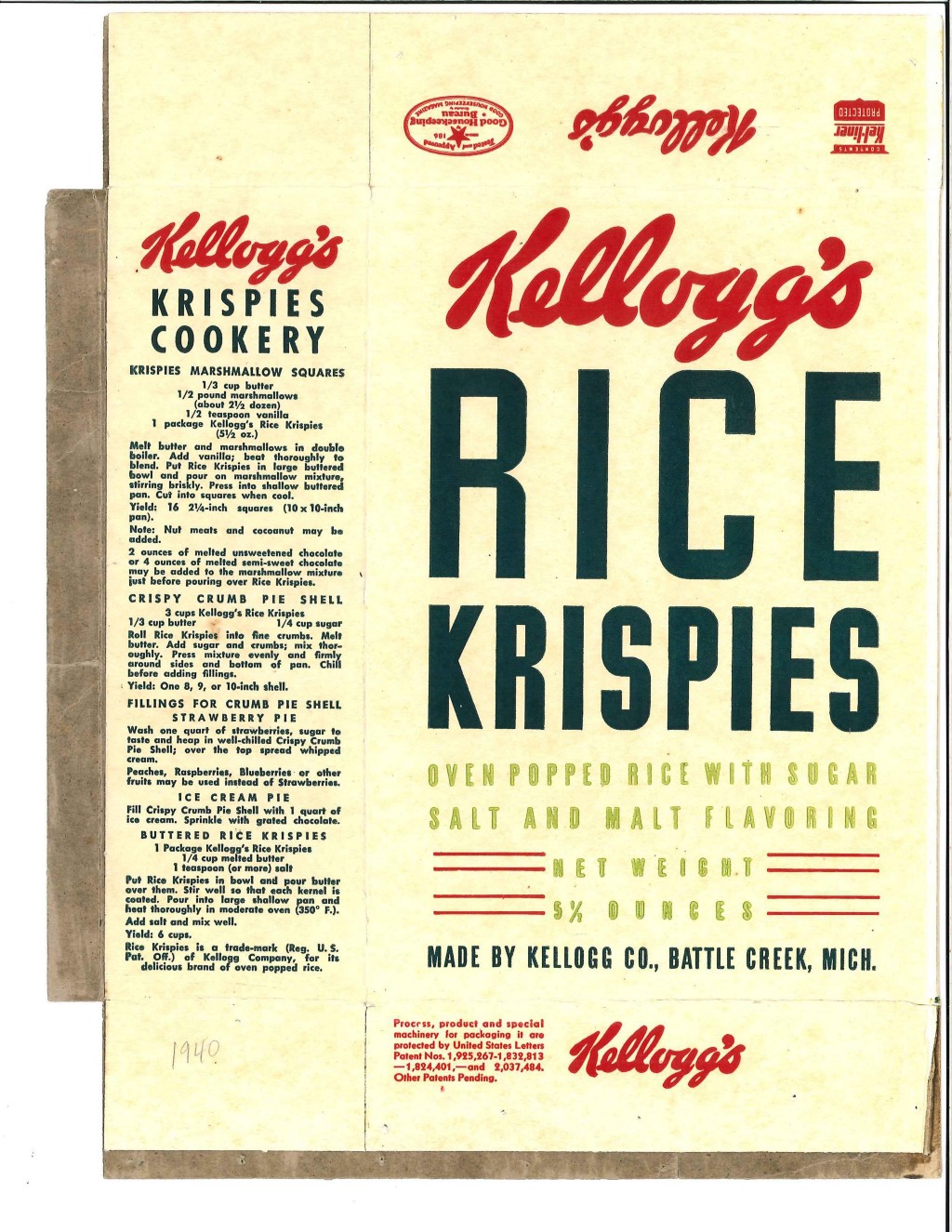
Kellogg has every right to their timeline, but it does seem odd not to at least acknowledge the earlier version of the treat in the company history. The probable cause (and this is pure deduction on my part) is that a large corporation, fearful of hungry lawyers, is probably slow to dole out individual recognition of a treat that has helped sell many billions of dollars’ worth of cereal.
Regardless, I needed something explicit from Kellogg. I needed closure. Something that would tidy up all the various bits of information tying Mildred to the Rice Krispies Treat. A simple, pleasurable denouement. I sent my last desperate (prodding, pushing) email to my virtual Kellogg girlfriend:
To confirm, the 1932 treats (the ones without marshmallows) were still called Rice Krispies Treats? However, Kellogg’s is recognizing the 1939 version (the one with the marshmallow) as the year the treats were invented? Correct?
And finally, is there anyway to confirm that Mildred Day had anything to do with the 1932 version?
The delayed response arrived. It was graywashed corporate-speak, but there were glimmers of a more complicated origin story in the layers of carefully chosen language. I knew it was all I would get. I took it.
The 1932 recipe was called Rice Krispie Bars (without the marshmallows). Mildred was employed between 1928–1933 and 1935–1936 so she was part of the staff when the recipe was developed.
Kellogg Company recognizes 1939 as when the now known as Rice Krispies Treats were invented.
Finally, it should be noted that Malitta Jensen is often mentioned in several articles as the co-creator of the Rice Krispies Treat. I could not find anyone to corroborate this information, though it would stand to reason that Jensen had something to do with the 1932 version (the marshmallow-less one) and she deserves equal recognition. As with all creation myths, the web is rife with misinformation and interpretation about Rice Krispies treats — timelines and appropriation shift from article to article. For the purposes of this article, I solely used Kellogg’s research/media department and Mildred’s daughter, Sandra Rippie, to put the puzzle together.
Mildred would be happy, I think. The Rice Krispies treat is having a revival of sorts. It is on trend. It was (mostly) gluten-free before gluten-free was a thing. And it is relatively low in fat and calories. Pinterest is rife with riffs on the treat. Industrious and famous cookbook authors are reinventing it for a new generation. Deb Perelman, of Smitten Kitchen fame, included a recipe for Salted Brown Butter Crispy Treats, in her best-selling cookbook, The Smitten Kitchen Coobkook and Amanda Hesser included a Caramelized Brown Butter Rice Krispies Treats recipe in The Essential New York Times Cookbook.
I like to think I am doing a little bit more to raise Mildred’s Q-score. In the newish Baked cookbook, Baked Occasions, I (along with co-author Renato Poliafito) pay homage to Mildred with a completely goofy (but fun) recipe—a Chocolate Rice Crispy “Cake” with Homemade Marshmallow “Icing,” to be consumed and celebrated on Mildred’s birthday.
Matt Lewis is a founder of BAKED and an occasional cookbook author. He hates cilantro and loves chocolate cake.
Don DeLillo's 'End Zone' Is The Sports Film We Need In 2017
The film has remained in pre-production purgatory for nearly ten years.
In End Zone, Don DeLillo’s 1972 tragicomic second novel about college football, Coach Creed cancels Friday practice. He is “famous for creating order out of chaos, building good teams at schools known for their perennial losers,” and needs to shake things up. He tells the team to have a party that night: “no coaches, no females, no time limit.” Mass vomiting is followed by singing, wrestling matches, push-up competitions, mock bullfights, ketchup-chugging, and then a pissing contest: “not for distance but for altitude.”

Team captain Gary Harkness calls it the “most disgusting, ridiculous and adolescent night I had ever spent.” The Logos College Screaming Eagles soon travel to West Centrex Biotechnical Institute, where they spend their pregame warmup engaged in ritual chanting. Then they burst out of the stadium tunnel and look up at the fans, “Americans on a Saturday night,” congregated to watch violence. DeLillo delivers: 30 pages of methodical game description with the occasional theological or cosmological aside, ending with the quarterback playing a football board game in the locker room.
End Zone skewers the world of football with a smirk and a tear. DeLillo was used to mocking things he loved; he said the Jesuits at Fordham taught him “to be a failed ascetic.” One particular French Jesuit — the paleontologist Teilhard de Chardin — remains a philosophical influence. Teilhard’s best known theory is the Omega Point, the evolutionary trend of the universe toward synthesis, an ultimate consciousness. Harkness channels Teilhard in the Texas desert; he is an exile, an outcast, an intellectual convinced death is coming, either on the gridiron, from nuclear holocaust, or both. End Zone is a novel about coming disaster: on the football field, and in war zones. It might as well have been written in 2017.
DeLillo’s guilty love for the game is palpable in his lyric descriptions, a postmodern version of NFL Films. Somehow the novel has never made it to the screen. But it came close once. Fresh off the creepy kid flick Joshua, director George Ratliff was announced with an enticing take on the project. A native Texan, he called the novel “wonderfully subversive” and “M.A.S.H. on the football field.” his spec script caught the eye of DeLillo, and filming was to begin in New Mexico in 2008. Josh Hartnett was cast as the brooding Gary Harkness. Kat Dennings, who said the script was one of the best she’d ever read, was set to play Myna Corbett, Gary’s eccentric girlfriend (in the novel, she wears a dress printed with an atomic bomb’s mushroom cloud; in one of the story’s climactic scenes, they have sex in the library). Sam Rockwell was chosen to play mouthy Wally Pippich, the college’s sports publicist who “don’t know squat about football . . . I’m talking human interest. I’m talking dramatic balance.”
It could have been wonderful. Yet the film has remained in pre-production purgatory for nearly ten years. Somebody needs to jump on this project right now. I can’t think of a better book to resurrect into a film for our increasingly entropic world than End Zone. I’d like to see what William Friedkin would do with it, maybe even the Coen brothers. Think Oliver Stone’s Any Given Sunday, populated with linguistics majors and Alan Zapalac, a weirdo professor of exobiology who convinces Gary to smoke a joint before a game as a “scientific experiment.”
DeLillo’s entire novel might be an experiment, a synthesis of subplots and random characters, exiled to the desert, where the coach surrounds the field with canvas blinds to hide their training. Dynamo running back Taft Robinson transfers from Columbia to Logos before tiring “of white father watching me run.” An All-American turned monk, he decides that his “new way of life requires a new language,” one of contemplative silence.
An assistant coach commits suicide with his ivory-handled Colt .45. Linemen debate whether Sir Francis Drake or the prophet Isaiah was the greater man. Coach Creed rapidly loses weight, becomes remote, and stands silent in a tower during practice like an absent God. The players describe him as “part Satan, part Saint Francis.”
Gary walks two miles in the desert to a motel, where he takes ROTC classes with an eccentric major whose father was part of the crew that dropped the bomb on Nagasaki. Major Staley says war is the ultimate game. Gary becomes obsessed with the language of mass destruction: “men embedded in the ground, all killed, billions, flesh cauterized into the earth, bits of bone and hair and nails, man-planet, a fresh intelligence revolving through the system.” DeLillo parodies the prevalence of the “football as war” metaphor, but cleverly doesn’t reject the metaphor itself. Zapalac rejects the idea that football is warfare because “Warfare is warfare. We don’t need substitutes because we’ve got the real thing.” And yet the real thing is never real in End Zone. War is practiced but never experienced. War is a game of language.
While the National Football League and the NCAA reel from domestic violence cases, the tragic legacy of a concussion epidemic, and other scandals, fans remain devoted. Like Gary, they are bored out of their minds during the offseason. They pine for fantasy leagues and office pools; Gary and his team play pick-up offseason games in the snow: “We kept playing, we kept hitting, and we were comforted by the noise and brunt of our bodies in contact, by the simple physical warmth generated through violent action, by the sight of each other, the torn clothing, the bruises and scratches, the wildness of all fourteen, numb, purple, coughing, white heads solemn in the healing snow.” For all of its artifice and spectacle, football is an elemental game, an autumn refrain. We could hate it, but we’d be hating a part of ourselves.
Despite early praise, End Zone has since been lumped with DeLillo’s comparably slight early novels like Running Dog and Americana. Time dismissed it as “much overpraised.” New York Magazine called it an “ultimately unsatisfying read.” That’s a shame. It is the best football novel that has ever been written, a prophetic paean to the terrible beauty of controlled brutality, a cogent and lyric explanation for why Americans can’t stop watching football. “A nation is never more ridiculous than in its patriotic manifestations,” Professor Zapalac warns. He was taking about football. Or maybe it was war. Does it really matter?
Nick Ripatrazone has written for Rolling Stone, The Atlantic, Esquire, and The Paris Review. He’s on staff at The Millions.
Jared Kushner Texts at Church

The TRUMP ADMINISTRATION is attending Mass before they leave Europe. POPE FRANCIS is finishing up his homily about how he can’t think of a less Catholic family than the Trumps. IVANKA is smiling and wondering how hard it really could be to convince a billion people to care about the bullshit you are selling. JARED is not smiling, but he is thinking about how satisfying it sometimes can be to accomplish simple tasks like pumping a car with gas, or taking a tenant to small claims court for minor property damage or completing a mandatory compliance training at work.
JARED [fidgeting in his pew, nervously]: I still have to do those mandatory HR trainings. One’s for harassment prevention and one is for like bullying in the workplace. Do you think I could access them on my phone here?
IVANKA [leaning in]: Every interaction you have with a female isn’t an opportunity to be mothered.
JARED [afraid]: You’re my wife though?
IVANKA [powerfully]: I don’t know where the training is. Ask Kellyanne. Better yet. We’re in St. Peter’s Basilica. Say a prayer the FBI doesn’t have the recordings of —
[JARED’s phone vibrates. It’s his brother JOSH commenting on his recent MyFitnessPal inactivity.]
JOSH [via MyFitnessPal app]: I noticed you haven’t logged any meals today. You ok, bro bro?
JARED [via MyFitnessPal app]: I’m in the Vatican. I’m doing some weird fast thing with the other Catholics on the trip. They won’t eat before they receive Communion or something.
JOSH [via text messaging]: Message me here, dummy. Fucking cathies.
JARED [liking JOSH’s comment, “fucking cathies”]: I’m effing starving.
JOSH: Nah, you’re probably just thirsty. Get some of that weird g-d water before it’s turned into wine lol.
JARED: Why do people always say I’m probably just thirsty when I say I am hungry?
[POPE FRANCIS invites poor people and MELANIA to the altar. He washes their feet and they all joke about how terrible everything on Earth is now and how disgusting TRUMP is.]
JOSH: Because you’re weak. You, need, like, a trigger warning for when Steph Curry effs around with his mouth guard.
JARED: Cavs in 7 btw.
JOSH: Omgggg no
JARED: Yeah jk. I have to say that because I think we won Ohio.
JOSH: Who the eff is we? The only thing keeping me from getting Lebron to run for Governor of the state of Ohio is knowing that defeating Kasich would make your father-in-law kind of happy. And why are you at a church with them? Does mom know?
POPE FRANCIS [to the congregation]: I believe in one God, the Father Almighty, creator of Heaven and Earth.
JARED [crossing his fingers with one hand and typing to JOSH with the other]: Did you see what we are wearing? It’s like we’re sitting shiva at the Olive Garden.
[POPE FRANCIS says something about Jesus’s blood and JARED feels faint. When he regains his bearings, JARED remembers hosting a blood drive his senior year of high school. It was literally the only thing on his Harvard application. The National Honor Society had hosted theirs a week earlier but a guidance counselor called a bunch of nurses and finagled another drive, so Jared could organize it and write a personal statement about the experience. The hospitals in Bergen County must’ve had so much blood that month, JARED thought.
STEVE BANNON enters and the building somehow does not crumble. He is yelling that Europe is a Christendom. Everyone, including POPE FRANCIS, shushes BANNON.]
STEVE BANNON [obstinately, because he hates being shushed]: And I fucking love that about Europe.
[STEVE BANNON takes his seat in the pew in front of JARED and IVANKA but first pisses in the holy water even nuns know not to bless themselves with. He says “beep beep” to KELLYANNE CONWAY so she makes room, as he glares at JARED who is still messaging his brother via MyFitnessPal.]
JARED [to JOSH, via MyFitnessPal app, again]: Ugh, Steve is here.
JOSH [via text messaging]: You’re a mess. Text me here. Look at your fucking life. Go for a run.
STEVE BANNON [staring directly at JARED]: Normally I would report people using their phones in Church to my friends at Opus Dei. [STEVE BANNON removes his phone from his cargo pocket and shares a meme of what baggage handlers do to your luggage at airport, except the meme says ‘they’ instead of ‘baggage handlers.’ He was late to Mass because he was editing the footage in his hotel room where he knew he would have the strongest wifi signal.] But, as they say, when in Rome.
POPE FRANCIS [clearing his throat, but not expecting much from this group]: Take this, all of you, and eat it.
JARED [via MyFitnessPal app]: brb I think they’re getting to the dinner part?
STEVE BANNON [reaching his back to rub it, and then hurting his back even more]: My back is fucking killing me. Can you hurry up and get to the wine part? [STEVE BANNON googles his symptoms.] I either have diabetes or something really bad.
KELLYANNE CONWAY [whispering quietly, hoping to least appear pious to POPE FRANCIS]: You don’t already have diabetes?
STEVE BANNON: I haven’t been to a doctor since they forced Ronald Reagan to acknowledge AIDS. [STEVE BANNON stretches all the way around in his seat, so his hot breath reaches JARED, who winces.] Hey Jacob. I saw the story in the Times Magazine about how you’re a slumlord in Baltimore. Jesus fucking Christ. I knew you were a wuss but are you also LARPing a lost season of the Wire?
POPE FRANCIS [raising a cup, but wanting to chuck it at the TRUMP ADMINISTRATION]: This is the chalice of my blood, the blood of the new and eternal covenant, which will be poured out for you and for many for the forgiveness of sins.
[JARED looks to IVANKA for help but she is reading customer reviews of her book, a bestseller.]
KELLYANNE CONWAY [now using her full-volume, Anderson Cooper-interview voice, but slurred with fewer mood stabilizers because she has been fasting]: You know, Jared, when the MSM profiles me, I am framed as a harried working mother who can do it all.
IVANKA [inflating her book’s Amazon rating and ranking, by creating fake user accounts like STEVE BANNON showed her]: It wasn’t a profile of him.
JARED and STEVE BANNON [for once, in unison]: It was a full-scale investigative report.
KELLYANNE CONWAY [googling furiously for the article]: Wait. Like the investigation?
[Meanwhile, TRUMP is receiving Communion. POPE FRANCIS looks up at the image of God painted on the ceiling and, in Spanish, negotiates that while he knows he is moving things a little fast here on Earth, he’d be willing to advocate redistributing only some of the wealth, if God could please please please smite the TRUMPS on a silly technicality, like using mobile devices in Church.]
KELLYANNE CONWAY [loading the article on her phone]: By the way, we need a name for the investigation. [She opens her Notes app and types, portmanteau of Jared plus treason?] Like only to use internally, I mean.
[The floor of the basilica splits open but none of the TRUMP ADMINISTRATION falls into Hell because this is real life and not a Christian allegory. SEAN SPICER group messages the staff, safe in their pews, to please pick him up a Church bulletin, and everyone deletes his text simultaneously.]
How Do Pet Psychics Talk To Animals?
I talked to some interspecies communicators to find out.
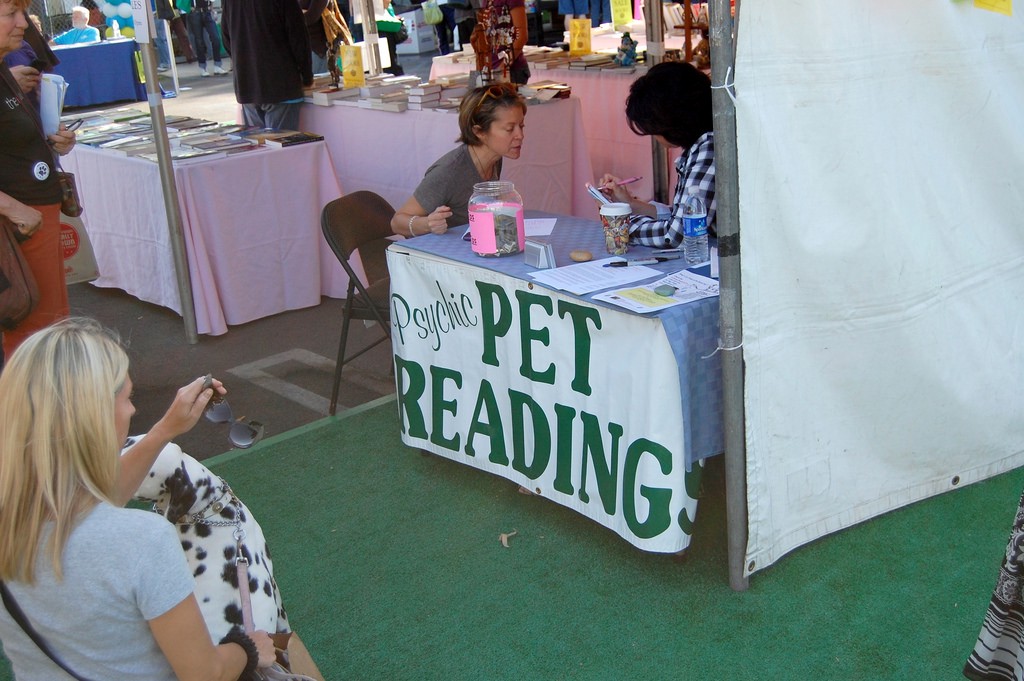
My family’s cat, Tiger, ran away when I was around eight. We searched for a few weeks, plastering our neighborhood with “Lost Cat” signs and offering a modest reward for his return. Eventually, my mom got desperate, so she did what any modern suburban mother would do: she called a pet psychic. And not just any pet psychic — as my mother attests to this day, she called “the pet psychic that talked to the 9/11 dogs.” Despite Syracuse, New York having a population of about half a million, Animal Wellness Consultants has two offices in the suburbs outside of the city. Between proximity, “the 9/11 dogs,” and only charging $45 for a twenty-minute session, my mom was convinced they’d lend some insight into our cat’s whereabouts.
Although the pet psychic lived less than a mile from our house, pet psychic sessions take place almost entirely over the phone. My mom paced around our house on the phone, after a few pleasantries but before she had even gotten to the lost cat, my horse, who was boarded at a farm about 45 minutes away, apparently cut in to share some of his feelings. The psychic said my horse wanted us to know that blue was his favorite color but he thought that he looked much better in red. (Objectively true.) He also wanted to know what was in the cans the owners of the farm would drink when they cleaned out his stall at night. He felt left out and wanted to drink some; eventually we let him drink beer. We never found the cat. The pet psychic did say that he was safe though, so that was nice to hear.
Since then, I’ve always wondered about the mechanics of being a pet psychic. It’s mostly just made me ask, over and over again, are we just assuming that animals think whatever language we speak? So I asked a bunch of pet psychics how it works.
“Thankfully for me, animals don’t think in a language like we do at all,” said Jennifer Mesenbrink, a pet psychic based in Iowa. They share feelings, which are the same regardless of where in the world they live.”
Similarly, California-based animal communicator Suzan Vaugh told me: “Animals communicate with me in pictures, smells, sounds and hunches. Sometimes ‘knowing.’ But we usually translate pictures into words for human understanding. It’s tricky interpreting the words and that’s where an animal’s person comes in. It can be a team effort!”
Okay, sure. Feelings are probably the same all over the world and “knowing” is pretty much indefinable but seems like a cool psychic word. But, if animals aren’t thinking in English, what exactly are they speaking in? Feelings seems like a vague answer.
Lori Spagna, a California-based animal communicator, gave me a brief rundown of the various ways that animals communicate. I trusted Lori because she has an assistant. Lori told me that the role of a pet psychic isn’t exactly reading minds, it’s translating what animals are already communicating into something that humans can understand. However, she cautioned me that “it takes a whole weekend course just to learn the basics and a lifetime to really develop it and mature it.” She said that training yourself to communicate with animals is a lot like going to the gym, we all have muscles but it’s our decision whether or not to work on them.
There’s different kinds of certifications in the interspecies communication world. A common one, and the one used by most of the communicators I talked to, is based around the philosophy and courses of Penelope Smith, “The Grandmother of Interspecies Communication.” While the prices of beginner courses “vary,” the more advanced seminars can cost somewhere between $500 and $1500 and a retreat will cost you about $100 a day.
The idea that anyone can communicate with animals was echoed by almost every pet psychic I talked to. Jamie Vaughn, a pet psychic from San Francisco, told me, “Animals communicate to me through pictures; sounds; thoughts; feelings and impressions… So, we all have the ability to communicate with animals no matter what language we speak because while we are verbalizing, we are subconsciously forming pictures in our mind. The animals are reading the pictures and the emotion behind our language — not the language itself.”
One animal communicator likened it to the ways that humans communicate without really noticing or speaking. Another one told me that we could all learn animal communication because it’s basically just strengthening that feeling you have when the phone rings and you just know who’s on the other line.
“I have had the experience of speaking with a dog that didn’t understand English because he was raised in a Spanish-speaking house,” said Shirley Scott, an animal communicator based in Oregon. “I don’t speak Spanish — we communicated through telepathy — pictures he would send me. So my experience is that an animal understands the language they are around. However, because telepathy is pictures and feelings and animals can communicate inter-species with it, language is really not a problem. Animals communicate with us and each other in the same way all humans do — with sound, body language, telepathy and pheromones.”
Through all my conversations, every answer seemed to circle back to “telepathy” as a kind of catch-all for animal to human communication. But what does telepathy really mean? Spagna suggested a few different ways this telepathy could occur: developing the pineal gland and pituitary glands (two glands in our brains that secrete hormones like melatonin, but communicators believe help us understand animal instincts), tapping into theta brainwaves (a hippocampal brainwave that many animals use but humans appear to activate during sleep, meditation, and hypnosis), “extrasensory intelligence in our hearts,” our gut feelings, and extrasensory feelings in our skin — goosebumps, for example. She says that, naturally, all animals and humans have these means of communication. It’s a matter of decoding them and translating them into human language.
What animals speak in is, according to Spagna, a universal language. “Animals speak in a language of energy,” Spagna explained. “It’s a universal language of energy that all beings speak. So this language of energy can easily translated into a variety of things.. It could be translated into light, different images of light and color. It could be translated into words, which could be any language. It could be translated into sensations, like feelings in the body or emotional sensations or feelings of touch or taste.”
The way the animal communicators translate this universal language depends on what “muscle” they’ve developed for telepathy; some will have physical feelings whereas others see pictures. Spagna said, “we might receive it as words, we might receive it as symbols or images or sounds or feelings of some kinds or another. But we’re translators. That’s really what animal communicators are, we’re taking information animals give us an translating it.” .
“Animals communicate multi-dimensionally,” explained Diane Samsel, a pet psychic in North Carolina. “When a communicator makes herself present to the animal’s energy then it becomes fairly easy to exchange communication (the idea is that everything in the universe breaks down to information). What is exchanged could be in the form of language, images — movies almost, whole concepts, sounds, sights, smells, bodily sensations and on and on. It seems like what is received depends on the communicator’s sensitivity. Animals are open books once they allow themselves to be ‘present.’ They share freely.”
Or, for an easier analogy, talking to animals is basically like making a .doc file into a .pdf in a world where most humans can only understand a .pdf. “Animals do not speak in English,” said Mary Getten, an animal communicator from Florida. “They speak via telepathy which is like a computer download. The animal sends concepts or information to the communicator, who translates that the into whatever language they speak (English, pictures, feelings, etc). So the concepts are transferred to the person and it comes through their filter into their language.”
If animals are always talking to us and we’re always talking to them and neither of us are really doing it on purpose, does this mean that there’s layers upon layers of communication that we’re missing out on everyday happening in our homes? Probably. That’s probably why your cat is almost always mad at you and your dog loves you unconditionally even though you’re kind of a bad pet owner sometimes, they are picking up your vibes at all times.
It also means that the animals you keep around know all your awful thoughts and behaviors that you think you can get away with in the privacy of your own home. As Spagna said at the end of our conversation, animals can “tell us what we don’t know about ourselves” and “know all our secrets.” So just, like, keep that mind if you ever feel like calling a pet psychic.

